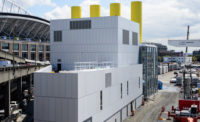When North America's largest tunnel-boring machine pushed a 50-ft-long, 8-in.-dia steel pipe seven feet out of the ground on Dec. 3, joint-venture contractor Seattle Tunnel Partners and Washington State Dept. of Transportation officials didn't think much of it.
"Bertha," the 57.5-ft-dia machine, kept churning its state Route 99 tunnel path below Seattle at faster-than-predicted paces. But only for three more days.
Now, that pipe—a well casing put in place in 2002 to measure groundwater movement following the 2001 Nisqually earthquake, the very same earthquake that serves as the catalyst for Bertha boring a tunnel to replace the aging and seismically endangered Alaskan Way Viaduct—may prove to be the prime cause of a month-long-plus shutdown of Bertha just over 1,019 ft into the 1.7-mile, $2-billion tunnel project.
With only a tenth of the project complete, Bertha has no time line for getting back to work.
The TBM first hit the pipe on Dec. 3 but appeared to simply rip right through it. Crews removed what they thought was all the steel, even if a few pieces appeared on the conveyor belt mixed with dirt. On Dec. 6, though, Bertha started slowing, prompting officials to shut it down to figure out what stood in the machine's way. Bertha hasn't moved since.
"Based on consultations with experts, if the pipe was there, the chances of having problems with the machine were pretty low," says Matt Preedy, the project's deputy administrator. "At that point in time, we were convinced it was probably something else."
Immediately before the slowdown, Bertha started spitting out large chunks of rock, Preedy says, indicating the possibility of a large boulder blocking the path. While that was the leading theory, 17 exploratory probes drilled in front of Bertha didn't hit any boulders, only something "metallic." The TBM is designed to shred only rock, dirt and concrete.
On Jan. 2, contractors finally reduced the water pressure enough to visually inspect a portion of Bertha's excavation chamber. They found a piece of an 8-in.-dia steel pipe protruding through an opening in the machine's cutterhead.
Other Culprits? Investigators Keep Working
Officials don't know, though, if this piece of pipe is the lone culprit, having inspected only the top 15 ft of the cutterhead. "We need to investigate further to see if there are other factors that could have contributed to the blockage," Preedy says.
Seattle Tunnel Partners (STP) may need to bring in tunnel-trained divers from Ballard Marine Construction, Washougal, Wash., to inspect the remainder of the cutterhead.
As crews prep for a further examination, finger-pointing has started on the slowdown that potentially could eat into the $145-million total contingency budget and put a December 2015 tunnel-opening date out of reach, although WSDOT isn't saying just yet that either are in jeopardy.
The initial salvo came from WSDOT, which wrote in a release: "The location of this pipe was included in reference materials in the contract." Chris Dixon, STP's project director, was unavailable for comment, but he told local media on Jan. 3 that his team figured the pipe had been removed before the bore began. Had STP known otherwise, its crews would have done the job themselves.
A time-consuming and costly extraction comes next, even though crews aren't sure whether the best plan for removing the broken pipe is through the cutterhead itself or from the surface, 55 ft from the top of Bertha. Figuring that out also comes sans a time line. During the shutdown, crews are replacing cutting tools that show unexpected wear and performing other critical maintenance.
"This is a sophisticated piece of equipment, and we have a long journey," Preedy says. "We don't want to push this thing until we have determined once and for all what the extent of the issue is. Is the pipe the only issue, or are there other issues? We want to make sure [Bertha] is in tip-top shape before we start going again."





